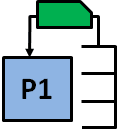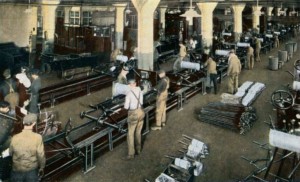 This last post of my series looks at fluctuations that originate downstream from your location. In other words, how to reduce fluctuations originating from your customer. Granted, this often is the most difficult one, as you usually have not so much influence over your customers (unless you have a monopoly). Let’s have a look.
This last post of my series looks at fluctuations that originate downstream from your location. In other words, how to reduce fluctuations originating from your customer. Granted, this often is the most difficult one, as you usually have not so much influence over your customers (unless you have a monopoly). Let’s have a look.
Material Flow
Reducing Fluctuations on Your Shop Floor
Reducing Fluctuations Upstream
 This post will list a number of tools that can help to reduce fluctuations. They can reduce fluctuations in the material flow, including its inventories and the durations and lead times. Since reducing fluctuations (mura) is an underlying important idea throughout lean manufacturing, a lot of tools can help. And, depending on how you interpret tools, this list is not even complete.
This post will list a number of tools that can help to reduce fluctuations. They can reduce fluctuations in the material flow, including its inventories and the durations and lead times. Since reducing fluctuations (mura) is an underlying important idea throughout lean manufacturing, a lot of tools can help. And, depending on how you interpret tools, this list is not even complete.
Structure for Reducing Fluctuations
 This post looks at how to reduce fluctuations (mura) in manufacturing. It is a continuation of the previous post that looked at why fluctuations are so bad. Be warned, tackling fluctuations is often a tedious task that never ends, but it one of the important fundamentals for lean manufacturing. After all, the more stable a system runs, the more efficient it is. Leveling is one major method to reduce fluctuations that focuses on the production schedule. Line balancing is another one that focuses on the work content.
This post looks at how to reduce fluctuations (mura) in manufacturing. It is a continuation of the previous post that looked at why fluctuations are so bad. Be warned, tackling fluctuations is often a tedious task that never ends, but it one of the important fundamentals for lean manufacturing. After all, the more stable a system runs, the more efficient it is. Leveling is one major method to reduce fluctuations that focuses on the production schedule. Line balancing is another one that focuses on the work content.
Why Are Fluctuations So Bad?
 Fluctuations are bad for manufacturing. In lean, unevenness is one of the three evils, besides waste and overburden. In this post I will give you an introduction to fluctuations. One option to handle fluctuations is decoupling, but this addresses only the symptoms and not the cure. In my next post I will show you how to actually reduce fluctuations.
Fluctuations are bad for manufacturing. In lean, unevenness is one of the three evils, besides waste and overburden. In this post I will give you an introduction to fluctuations. One option to handle fluctuations is decoupling, but this addresses only the symptoms and not the cure. In my next post I will show you how to actually reduce fluctuations.
When NOT to Balance a Line
 Line balancing is one of the important methods for improving your production system. The idea is to give every process the same workload so all processes are busy all the time. However, there are cases where it may be better NOT to balance a line. This post will look into when and why you may choose not to balance your line.
Line balancing is one of the important methods for improving your production system. The idea is to give every process the same workload so all processes are busy all the time. However, there are cases where it may be better NOT to balance a line. This post will look into when and why you may choose not to balance your line.
Toyota’s Six Rules for Kanban
 The kanban system is the most famous way to establish a pull system. As part of their guidelines for kanban, Toyota has established Six Rules for Kanban. They can be found, for example, in the 1973 Toyota Production System Handbook. This blog post describes these six rules, based on the Toyota handbook. While these rules are all true, they are in themselves not sufficient to establish a kanban pull production. Nevertheless, this post will show you these six rules.
The kanban system is the most famous way to establish a pull system. As part of their guidelines for kanban, Toyota has established Six Rules for Kanban. They can be found, for example, in the 1973 Toyota Production System Handbook. This blog post describes these six rules, based on the Toyota handbook. While these rules are all true, they are in themselves not sufficient to establish a kanban pull production. Nevertheless, this post will show you these six rules.


